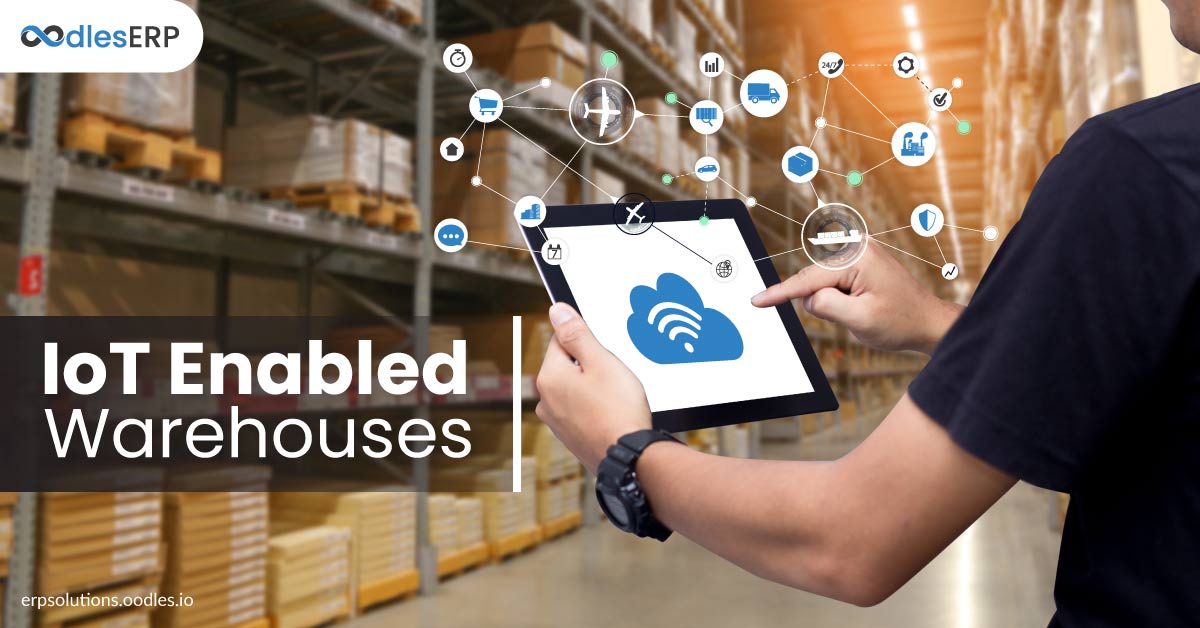At Oodles, we provide supply chain software development services to make supply chain operations seamless and eliminate third-party entities.

Benefits of Using IoT in Warehouse Management
Real-time Product Tracking:
IoT enabled warehouses gives businesses real-time data on product locations, transportation details, packaging, and routing. Due to these instant updates, store managers ensure no inventory is lost during transportation. Also, they ensure supply chain vendors manage deliveries responsibly.
Enhanced Visibility:
RFID technology enables businesses to track goods that enter and leave the warehouse in real-time. It results in stronger inventory control and gives businesses the ability to dynamically modify orders. IoT devices enable store managers to gather warehouse and supply chain data in real-time and share it with customers.

At Oodles, we enable real-time traceability of products with RFID tags containing timestamps and product information.
Improved Inventory Management:
Smart shipping containers and shelves full of connected products will make it easy for store managers to locate and manage inventory in the warehouse. These systems can automatically generate alerts if the product is out-of-stock or temperature conditions are affecting the quality of goods. In addition, IoT devices make it easier for store managers to manage returns as they have relevant information like status, location, and ultimate point of disposition.
Reduces Risk:
Using IoT devices in warehouses enables businesses to detect risk and avoid accidents that can create disruptions in the supply chain. IoT sensors in warehouses can monitor temperature conditions. In addition, data gathered from vehicles, shipping conveyances and products can be combined to reduce counterfeiting, theft, and spoilage.
Predictive Maintenance:
A predictive maintenance system detects early signs of equipment malfunctions enabling the store managers to avoid downtime and stock spare machinery.
IoT Enabled Warehouses: Use Cases
Autonomous Mobile Robots (AMR):
AMR is a popular IoT technology used by businesses to move or handle products within the warehouse. Autonomous robots can move independently and use navigation sensors and cameras. Unlike Automated Guided Vehicles (AGV), AMR do not operate on a fixed path. Instead, they sense and perceive the environment, find their specific position, analyze and then execute the movement.
The use of AMR is critical for smart warehouses. Businesses use robots to transport and move shelves to workstations. They share the workload of the warehouse workers by reducing the travel of the order picker. Autonomous robots contain an integrated scanner through which they confirm the picked item. In addition, AMR has sensors that track data so that feedback can be provided to warehouse managers.
Smart Glasses:
Smart glasses enable warehouse managers to view visual displays of order picking instructions and information associated with the location of the item. Through smart glasses, warehouse managers can also decide where to place a certain item/product on the cart. In addition, smart glasses are user-friendly and reduces onboarding and training times.
Advantages of using Smart Glasses for Picking:
Enhanced picking performance
Better picking accuracy
Enhanced ergonomics
Key Business Players Using IoT Technologies for Smarter Warehouse Management
Amazon Warehouse Automation:
It is a leading American multinational technology enterprise that focuses on e-commerce, digital streaming, cloud computing, and artificial intelligence.
Amazon uses a semi-automated warehouse management services where robots work alongside store managers. Basic tasks like scanning barcodes and moving packages are outsourced to IoT devices. Amazon's automated warehouse employees has 400 robots to perform these basic tasks.
IoT devices enable warehouse managers to track inventory, improve productivity and make the entire supply chain process smoother and efficient.
DHL Smart Warehouse:
DHL is a leading global brand in the logistics industry. It provides logistics services ranging from national and international parcel delivery, international express, e-commerce shipping, and fulfillment solutions to the industrial supply chain management.
DHL has piloted an extensive range of IoT devices at its warehouses. The organization uses robots, smart glasses, autonomous vehicles, and drones in its warehouse. These IoT devices enable store managers to identify products and sort through parcels easily and efficiently.
In today's scenario, warehouses are more than an inventory and storage facility. Most organizations are investing in IoT enabled warehouses to improve the operational efficiency of their supply chain by reducing costs.
At Oodles, we provide warehouse management software development services using IoT architecture that is suitable for sensor technologies. Our IoT enabled warehouses services include intelligent processing leading to more control on data storage.
If you want a smart warehouse monitoring solution, then connect with our ERP team to schedule a discussion!
To Read Next: Key Trends for Supply Chain Management in 2020









